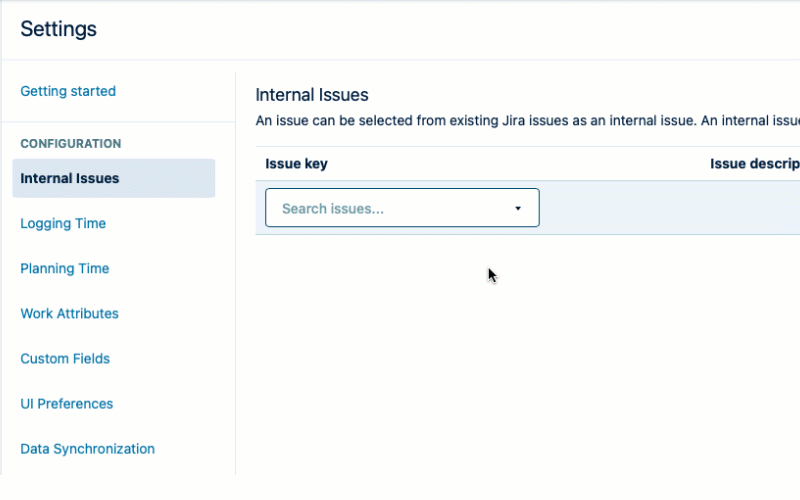Creating and Configuring Internal Issues
How to create and configure Internal issues
Important
Configuring internal issues requires the Tempo Administrator permission.
Internal issues are Jira issues that you create to manage time spent on non-project activities across your organization, such as company meetings and events, onboarding, and internal training. Most often, Internal issues are used for tracking time that your organization needs to account for, such as vacation, sickness, parental leave, or a scheduled medical leave.
Tip
Internal issues are not used for public holidays. To do that, you must set up one or more holiday schemes for your organization.
After the Internal issues are created, Tempo administrators can configure Tempo so that the issues can be identified and used properly in Tempo Timesheets, Tempo Planner, and Tempo Cost Tracker.
Users can plan time and log time quickly on internal issues because they're all grouped together on the Internal tabs in the Issues side panel in My Work and the Resource Planning view, as well as in the Log Time and Plan Time forms.
In Tempo Timesheets, time logged to internal issues may be included in the billable hours, but it’s typical that these issues aren’t billable, such as vacation or sick time. To keep hours logged to internal issues separate from the billable hours, it's recommended to set up a non-billable account for the internal issues.
If you're tracking revenues in Cost Tracker, internal issues are not considered billable so they are automatically excluded from revenue calculations.
Watch this video to learn how to create and configure Internal issues:
What level of privacy do you need?
Depending on the level of privacy that your organization requires, there are two paths to follow for working with Internal issues:
If you want all Tempo users to be able to view and log time to Internal issues, you can configure any issue from any Jira project as Internal in Tempo (see Configuring Internal Issues in Tempo below). Tempo handles the Project permissions for each issue so that you don't have to separately give these permissions to all the groups in your organization. Of course, it's best practice to create a single Jira project to keep all Internal issues together for easier housekeeping (see below).
If privacy is a concern to your organization, such as if you have external contractors accessing your Tempo instance, there are a few things you should do. It's recommended that you first create a separate Jira permission scheme and a separate Jira project to house these internal issues. With a separate permission scheme, you can control the access to these internal issues with Project permissions. Most importantly, do not configure these issues as Internal in Tempo since doing so will override your Project permissions and give access to all Tempo users.
Creating an Internal Jira project and issues
Important
Creating Jira permission schemes and granting Project permissions requires Jira Administrator Permissions.
While not mandatory, it's best practice to create a dedicated Jira project to keep all the internal issues together for your organization for easier management. Doing so ensures that all internal issues are easily identified because they use the same project name, such as "INT". As well, it's simpler to run reports later at the project level when all Internal issues are in the same project.
To create internal issues:
If your organization requires privacy, first create an Internal Jira permission scheme - see Managing project permissions (Atlassian documentation). Then grant the appropriate Project permissions to only those who need access to this data.
Create a Jira project with an easily identifiable name and key (such as INT).
Create all the Jira issues to cover your organization's non-project events. You can always add more issues later, but it's best to create most of them before your employees start logging time to them.
Remember that internal issues should have no Original or Remaining Estimate, no Due Date, and no Assignee.
Do either of the following depending on your organization's situation:
- Configure the issues as Internal in Tempo (see below) so that everyone can view and log time to them.
- If you require privacy, do not configure these issues as Internal in Tempo (see below).
Tip
If internal issues are in a separate Jira project, it's easy to run reports on that project to see the number of hours logged to or planned for on each Internal issue, such as to find out how many sick days have been taken for the month.
Configuring issues as Internal in Tempo
When you configure Internal issues in Tempo, you select the existing Jira issues that you have created for this purpose and add them to a list of issues that are marked as "Internal". This lets Tempo know that these issues are special, and are automatically used to populate the Internal tab in the Log Time and Plan Time forms, and in the Issues side panel in My Work in Tempo Timesheets and the Resource Planning view in Tempo Planner.
When you configure a Jira issue as Internal, Tempo automatically makes it available to all Tempo users, regardless of its Project permissions. This makes it easy for administration since you don't have to separately give these Project permissions to all the groups in your organization. However, if your organization requires privacy at this level, it's recommended that you do not configure issues as Internal in Tempo so that their Project permissions are retained.
To configure Jira issues as Internal:
Select Settings
 in the Tempo sidebar
in the Tempo sidebarUnder Configuration, select Internal Issues.
In the Issue Key search box, select a Jira issue that you want to consider as Internal for Tempo.
Click Add.

To delete an internal issue, click Delete for the issue you want to stop using as an internal issue. The issue is no longer marked as Internal for Tempo, but is not deleted from Jira.